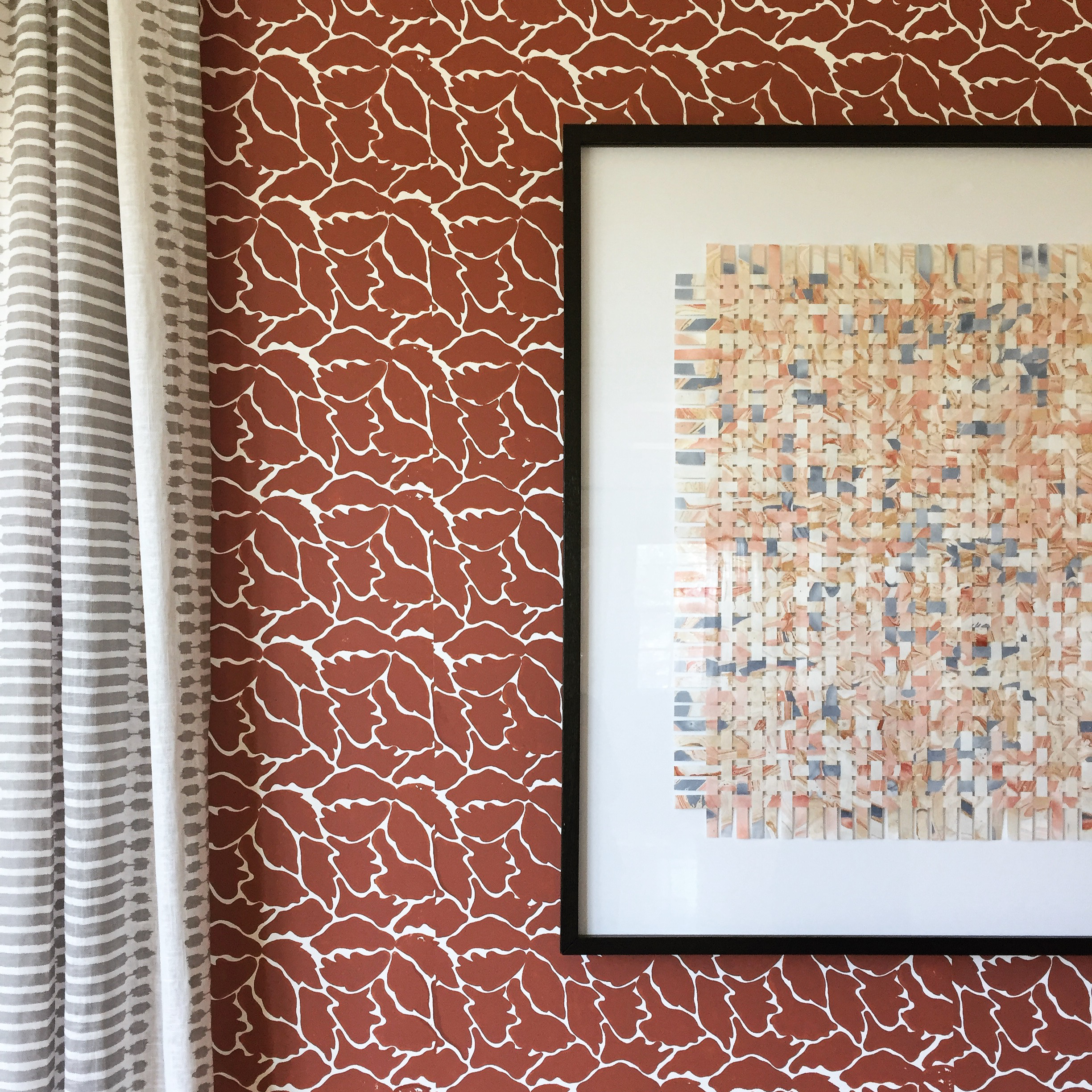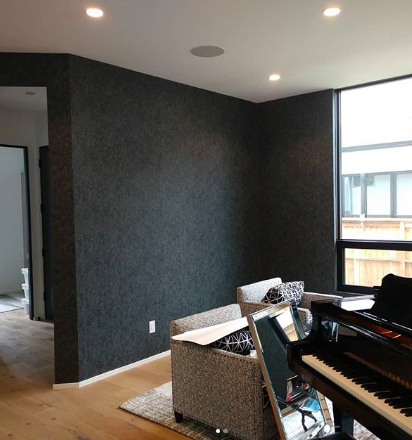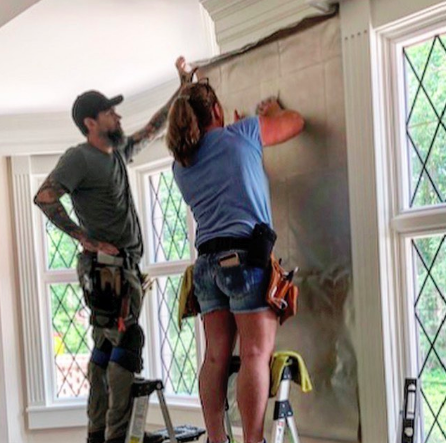As a wallcovering installer, we are faced with mastering the latest materials that are coming out into the market. We are at the mercy of our fellow manufacturers and the materials, trends, and types of paper they come out with each year. For this reason, wallpaper hanging will never be a boring trade. It won’t be easy either. Most wallpaper hangers apprentice up with seasoned craftsmen in the trade. Even with an apprenticeship, wallcovering takes dedication, research, and drive.
Things You Can Learn at the Convention—
What is Muslin?
Muslin is a lightweight, often khaki-cotton material with no pattern. It is often found used as drapery, pillows, and patterns for sewing kits. When used for wallcovering, it is used around sinks, as a liner under delicate papers, over shiplap, logs, and textured walls, and all to create a flat, removable surface. When seeking to obtain muslin, the material can be purchased online or at any local fabric store. For wallpaper hanging, the installer is looking for muslin designated as unbleached and lightweight. If shopping online, you are looking for Rosbrand, a manufacturer of “theatrical fabrics, custom curtains, and production supplies.” Jeff Ragland, of Ragland Wallcovering & Decorative Arts LLC, will be hosting sessions throughout the course of the convention this year on everything you need to know about hanging muslin.
It tends to be used most often in America versus other regions around the world. Ragland will be sharing how muslin is used for its ease of removal as well. “Muslin also gives stability to a wall due to the light fabric properties of the material,” states Ragland. The wallcovering installer will hang the muslin first, then hang a scenic or the designated paper over the fabric.
Why Use Muslin
Muslin tends to be used on historical projects since older structures need to be preserved. In older structures, there may be cracks in the walls, there may be accent walls made of shiplap, and other textures that can cause paper to tear. Rather than using sheetrock over the wall, muslin can be used to preserve the architectural integrity of the property. It’s also important to understand the benefits of using muslin as a more flexible option. Using muslin as a precursor to any paper will create a flat surface effective in smoothing over wall cracks, while keeping the paper smooth and professional. Muslin also requires no primer and is quicker than adding lining, and faster than plaster. According to Raglan, knowing how to work with muslin opens up the opportunity to more lucrative jobs, since the alternative, plaster, is a more time-consuming service.
When to Use Muslin
Muslin tends to be less expensive solution as opposed to other wall hanging materials used for primer coverings like plaster. It’s good to know how to handle Muslin, and when to introduce it into a job. For example, when the client has a need to keep the integrity of their walls intact upon removal of the wallpaper, muslin is your best bet. The technique of stapling the material to the wall before hanging the paper, provides a mechanism in place so that walls are not damaged when the wallpaper needs to come down.
How to Work with Muslin
Ragland will be demonstrating the material using a demo wall, paste, and staples at the convention in Cincinnati. He will show the steps of stapling the material to a wall, then wetting the material so that it shrinks to the surface area and pulls tight, so that you have a finished professional surface.
In the time available, there will also be opportunity for hands on practice at the wall. This combination of watching a live demonstration and then applying what you’ve learned helps to solidify the technique in a matter of days.
Who: About Jeff Ragland
As is common for many of the now professional wallpaper hangers, the scenario for influencing one into the trade is by accident. For Ragland, he was taking a break from college and living with a friend from Ireland. From that friend, Ragland was introduced to another painter friend where he fell into a seasonal summer job with a paint company known as HJ Holtz and Son. The paint company would also subcontract work out to, “a wallpaper guy,” Richard Humlan. That one seasonal summer job turned into year-round gig and full blown, 20-year career. It was over decades at HJ Holtz and Son that Ragland began to work under Humlan; where he would learn the trade.
That was some 20+ years ago. Today, Ragland installs all types of high-end residential, historic buildings, museums, and digital graphics, in addition to, offering decorative painting as part of his service offering. He only recently went out on his own to create Ragland Wallcovering.
The first project Ragland recalls using muslin, was a scenic french brand, Zuber, used in a dining room over wood block. Zuber has been in rotation for over 300 years and consists of papers with temperate paints and water soluble art, so much so, that application has to be done completely dry. Not only is the paper delicate, but in this instance the client required the paper to be easily removed as well. The project included pasting the muslin with wheat paste, then lightly misting the muslin with water, letting it dry and trimming the excess off.
Gaining experience with the material served important in Ragland’s career, as he cites approximately half a dozen projects or more coming in yearly requiring the technique. It’s tricky to do the first couple of times, so learning under someone who is experienced will go a long way to mastering the material.
Where Ragland Goes for Inspiration
If you are curious as to what a 20-year veteran tradesman reads on his down time? We asked Ragland and he cites Elle Decor, Dwell, Veranda Magazine, and Southern Living. These magazines, although, not always focused on wallcoverings will display color ways, introduce designers and hint at what is to come. As to specific designers that stand out to Ragland, he had a hard time choosing, but to get you started on your research, check out Ralph Harvard for his historic work and Janie Molster Designs.
The Purpose of Joining a Professional Trade Association
Supplementing apprenticeship and independent research, the Wallcovering Installers Association (WIA), a nearly 600-member professional association dating back to the 1960s, provides materials, live events, and education (amongst other benefits) to bridge the gap. This year at the Wallcovering Installers Association Convention, taking place in Cincinnati, Ohio, dozens of gifted and experienced speakers are hosting sessions to pass down their expertise to their fellow hangers both seasoned and next gen hangers alike.
While the event is discounted for WIA members, non-members in the community are welcome to attend. There are even pre-convention sessions for attendees that are thinking about adding wallcovering to their skillset, pivoting from painting to wallcovering, or looking to join the association for professional advancement and accreditation.
Parting Ways
If you are a painter thinking about expanding your craft, entering into a niche field, or are a seasoned paper hanger looking to expand your toolset, Ragland advises, to “find someone to learn from.” Know that beyond muslin, wallcovering installation takes effort and passion. You will be learning something new with every job. There are constantly new products, types of paste, and types of material out there to keep you on your toes. The path to success as a wallcovering installer requires passion, dedication, and years of hands on experience. Becoming a member for Ragland means he can extend his research into the vast pool of nearly 600-members and dip into individual expertise across the membership-base knowing that certain people are better at different techniques, because as stated by Ragland “people [members] can push you into the direction you need to go.”
If you want to attend the 2019 WIA Convention, you’ll want to review the agenda and sign up now.





